This blog post was written by Erica Marie Hartmann, Assistant Professor at Northwestern University (profile, Twitter).
Last week, the International Societies of Exposure Science (ISES) and Indoor Air Quality and Climate (ISIAQ) had their joint meeting in Kaunas, Lithuania. The meeting featured a lot of great research on topics ranging from the thermal comfort of clothes to exposure to heavy metals from e-cigarettes and everything in between. While we can’t summarize the whole meeting here, we can give you a taste of what happened in the Sloan-sponsored symposium on “Integration of Biology and Chemistry for Indoor Environmental Quality.” Enjoy, and see you next year in Seoul!
The idea behind this session is that both chemistry and microbiology can have big impacts on the experience of the people in buildings, and indoor chemistry and microbiology can also influence each other. Our session kicked off with Glenn Morrison talking about the CHEMM project, which sets out to answer the question: How does humidity affect microbial and non-microbial volatile organic chemical (VOC) emissions in building materials over time? Pawel Misztal and his team have measured VOCs using an “exquisitely sensitive” PTR-TOF-MS. They are working on disentangling VOCs from biotic and abiotic sources. So far, what they’ve found for both is surprisingly that abundance isn’t as important as relevance to human health effects or other concern. Some molecules may have outsized impacts relative to their abundance. As they put it, “Nonabundant compounds can also be important!”
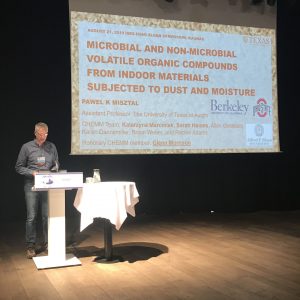
Not everyone is as fascinated by VOCs coming out of microbes. In fact, many of us just want the microbes gone. But sometimes in our quest to get rid of them, we introduce new VOCs by using chemicals such as bleach. James Mattila told us about his research looking at how bleach influences indoor air quality/chemistry of the indoor environment. When you mop the floor with bleach, the bleach starts to acidify and produce HOCl, which then volatilizes, forming chlorine gas after interaction with indoor particles. James showed that, with each application of bleach, there is a rapid spike and then decay of HOCl and Cl2. You might think chlorine gas is nasty enough, but the story doesn’t end there. Enter sunlight, which leads to the formation of secondary organic aerosols, which are linked with negative health outcomes. Luckily, a lot of these harmful emissions stick to surfaces, but there’s lots of consequences to weigh before reaching for the bleach!
Taking a deeper dive into how surfaces impact indoor air chemistry, Madeline Cooke from the Ault group focuses on how the pH of the microscopic layer of water affects chemical reactions. Madeline uses a special technique called AFM-IR, which provides simultaneous physical and chemical information about surface films; combined with visible light, you get a spatial resolution of 1 micron! This resolution is important for differentiating surface types because even things that look relatively similar with the naked eye can be very different at the micro- and nano-scales. These pH gradients change protonation of the species dissolved in the films of water on the surfaces, which in turn changes volatility. Looking at pH at such a tiny scale could turn out to be really important for things like James’ study of bleach.

VOCs aren’t the only thing that care about water availability and pH on surfaces. Microbes definitely have thoughts on the matter too. Alexander Mahnert told us about the microbes in confined environments, such as the Hawaii Space Exploration Analog and Simulation (HI-SEAS IV), a really comprehensive simulation of life in space. His team sampled both indoor surfaces and crew skin to see what might happen to people on long missions in space. Microbial abundance was highly variable over time, both on crew and on surfaces, especially when there was an issue with the toilet and the crew fixing it didn’t have adequate protective equipment – yikes! Plumbing issues aside, the findings from this study were pretty surprising. Normally, the microbes on indoor surfaces reflect the human inhabitants; here, the crew’s skin actually adapted to reflect surfaces. Note that these analyses are ongoing, and the results aren’t published. Maybe there’s some special surface chemistry going on in there that we don’t yet know about…
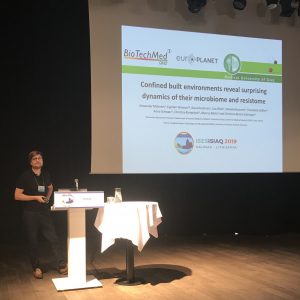
Indoor surfaces are home to water and microbes, but also organic films (aka “grime”). Rachel O’Brien wants to know more about what exactly “grime” is, so she’s developing new techniques to harvest these complex chemical mixtures to study them in the lab. Using solvent extraction, she looked at the grime that forms over the stove after cooking and identified some really large molecules, on the order of C50. These may be di- and tr-glycerides, but also a lot more stuff — probably products of oxidation. Having a thin (or thick) organic coat probably affects how water films form on a surface and whether VOCs or semi-volatile organic chemicals (SVOCs) stick to the surface or float away.
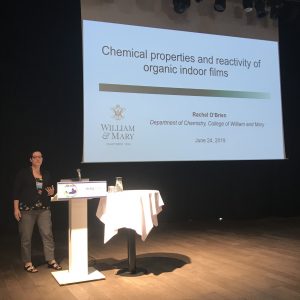
While most people might not care about a little water on an indoor surface, none of us are too happy to have a layer of grime. The presence of microbes on surfaces is a little more controversial. Erica Hartmann shared her research on the use of nanosilver to kill microbes on a somewhat unusual indoor surface – toothbrush bristles. Her group found that, while nanosilver does a pretty good job of offing the microbes in question, it also tends to come off of the toothbrush, which isn’t ideal. Much like using bleach to clean microbes on surfaces, there are some consequences to keep in mind when using antimicrobials like nanosilver in consumer products.

We spend a ton of our time in our homes, which is why it’s so important to understand the indoor microbiology and chemistry that happens there. To get a better picture of the whole range of phenomena taking place inside of a home, Marina Vance is leading the HOMEChem project. This immense, interdisciplinary project takes advantage of the test house at UT Austin and looks at lots of different aspects of home life, including cleaning (like with bleach) and cooking. In fact, the team put together an entire Thanksgiving dinner – multiple times! Nina monitored particulate matter, including black and brown carbon, in the home, as these are really important for human health and good air quality. Usually, indoor air quality was fine, but specific cooking events could make the air “unhealthy” to “very unhealthy,” especially for Thanksgiving. Nina notes, “one house is not representative of a whole community, but it allows us to investigate sources.” So maybe your house isn’t so bad – or maybe you don’t cook Thanksgiving dinner – but everyone should use proper ventilation when using the stove or oven.
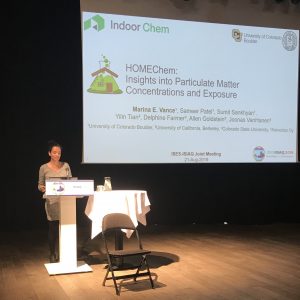
Of course, we don’t spend all of our time at home. Some of us also have to go to work, y’know! Lesliam Quirós-Alcalá is concerned about air quality in the workplace, particularly in hair salons. The US has some 95,000 beauty salons, nail salons, and barbershops, employing 1.2 million people, most of whom are women of reproductive age. The people who work in these salons are exposed to lots of chemicals with adverse health effects: occupational exposure to hair colorants is “probably carcinogenic.” Lesliam is particularly concerned about hairdressers in salons that serve African and Latino communities, as products for black hair are especially toxic. She’s working on a study to see how hair salons can improve their air quality and protect the health of their workers. But she’s run into some challenges, both in making the measurements, and in recruitment. Both technical solutions and community relations are needed to have bigger, better studies!
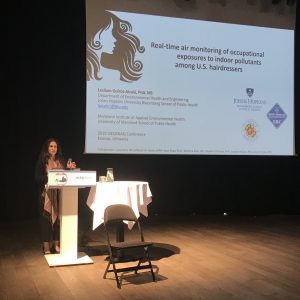
If your work happens to involve animals, you might want to think not just about how your occupation affects you but also the health of the animals. This is the idea behind One Health, and it’s especially important when diseases can jump between animals and humans (zoonoses). It’s also critical for controlling the spread of antibiotic resistance. Ana Rule studies whether concentrated animal feeding operations (CAFOs) industrial hog operations are sources of antibiotic resistance for the hogs, the workers, and their neighbors. One of the things that happens in these places is that waste is sprayed as a fertilizer. While it might be sprayed on fields, it really goes everywhere, like a community-scale version of the toilet malfunction Alex observed. Ana is still working on picking the best methods to detect antibiotic resistance, but results of related studies can be found here.
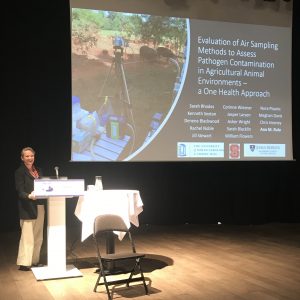
Of course, we academics work in schools, so we also like to study the school environment. Peter DeCarlo is particularly interested in particulate matter (PM). PM can come in from outside, but Peter says when it comes to indoor PM, “we are our own worst enemy.” One way that we add to indoor PM is through cigarette smoking. A couple of heavy smokers recently graduated from the Drexel, leaving traces of cigarette smoke in their wake. Of course, the school buildings are non-smoking. But even if you don’t smoke indoors, you give off an aura of cigarette smoke everywhere you go. Residual cigarette smoke can contribute 25-30% of indoor PM where heavy smokers were and can be transported around the building by the HVAC system. This stale cigarette smoke sticks to the walls and other surfaces indoors. However, for third-hand smoke to volatilize off the walls, you need water, which brings us back to where we started, looking at VOCs, surface-mediated chemical reactions, and the pH of water films!

In summary, the research in this session spanned microscopic pores on surfaces to whole communities of people. Looking at indoor air quality and exposures at all of these levels is really important to be able to understand exactly what is happening and how it affects the health and wellbeing of the people in the area. Model environments like HOMEChem and HI-SEAS are great for letting us control conditions and look at individual parameters, but field studies are critical to see what’s happening in the real world. While we think indoor environmental quality is really interesting, not everybody wants to know about it. So spread some #indoorchem and #MoBE love so that we can come study an indoor environment near you!
 This blog post was written by Erica Marie Hartmann,
This blog post was written by Erica Marie Hartmann,
Assistant Professor at Northwestern University (profile, Twitter).